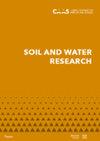The impact of forest naturalness and tree species composition on soil organic carbon content in areas with unnatural occurrence of Norway spruce in the Czech Republic
IF 1.7
4区 农林科学
Q4 SOIL SCIENCE
引用次数: 0
Abstract
Climate change has increased attention paid in the research to forest soils and tree species composition, in respect to the potential for carbon sequestration. It is known that forest stands are able to store soil organic carbon (SOC), but little is known about the effect of forest naturalness on SOC content. This is important in relation of dying of unnatural spruce stands. It is necessary to determine a suitable composition of tree species which will replace them. This research is based on 248 plots with oak, beech, and spruce stands and mixtures of these species, with measured values of SOC. Our results show that autochthonous and mixed stands, in terms of tree species composition, in the study area had a higher SOC content than allochthonous and pure stands. In addition, it was found that autochthonous oak and beech stands, especially in mixtures, had a higher SOC content than allochthonous spruce stands (monocultures). On the basis of the presented results, it is possible to optimize the future tree species composition of stands in the study area, which currently have an allochthonous representation of spruce, to provide better function of carbon sequestration and resistance to climate change.捷克挪威云杉非自然发生区森林自然度和树种组成对土壤有机碳含量的影响
气候变化使森林土壤和树种组成的研究在固碳潜力方面受到越来越多的关注。已知林分具有土壤有机碳(SOC)的储存能力,但森林自然度对土壤有机碳含量的影响尚不清楚。这对于非自然的云杉林的死亡是很重要的。有必要确定一种合适的树种组成来取代它们。本研究以248个样地为研究对象,其中包括橡树、山毛榉和云杉以及这些树种的混交林,并测量了土壤有机碳值。结果表明:研究区原生林分和混交林的土壤有机碳含量高于原生林分和纯林分。此外,本地栎树和山毛榉林的有机碳含量,特别是混合栎树和山毛榉林的有机碳含量高于外来云杉林(单一栽培)。在此基础上,可以优化研究区林分的树种组成,以提供更好的固碳和抵御气候变化的功能。
本文章由计算机程序翻译,如有差异,请以英文原文为准。
求助全文
约1分钟内获得全文
求助全文
来源期刊

Soil and Water Research
Water resources, Soil Science, Agriculture-WATER RESOURCES
CiteScore
4.60
自引率
0.00%
发文量
26
审稿时长
>12 weeks
期刊介绍:
An international peer-reviewed journal published under the auspices of the Czech Academy of Agricultural Sciences and financed by the Ministry of Agriculture of the Czech Republic. Published since 2006.
Thematic: original papers, short communications and critical reviews from all fields of science and engineering related to soil and water and their interactions in natural and man-modified landscapes, with a particular focus on agricultural land use. The fields encompassed include, but are not limited to, the basic and applied soil science, soil hydrology, irrigation and drainage of lands, hydrology, management and revitalisation of small water streams and small water reservoirs, including fishponds, soil erosion research and control, drought and flood control, wetland restoration and protection, surface and ground water protection in therms of their quantity and quality.
 求助内容:
求助内容: 应助结果提醒方式:
应助结果提醒方式:


